| Columns Retired Columns & Blogs |
EICO HF-81 integrated amplifier Measurements
Sidebar 4: Measurements
Although it does have 32 and 16 ohm output transformer taps, I measured the EICO HF-81 from its 8 and 4 ohm taps only, feeling that these will be optimal for use with modern speakers such as the mbls PB used for his auditioning. While I like the positive electrical connection terminal strips allow, those on the HF-81 are too close together to accept good spades, such as the Kimbers. I therefore used bare wire wrapped around the screws, but if you do likewise, be careful you don't short the live outputs with stray whiskers of wire.
An unexpected problem arose during the testing, due to the fact that the HF-81's Power switch is at the leftmost rotation of its right-channel Treble control. Consistently resetting this control to its center point after turn-on was an exercise in futility. In the following graphs, you get my best shot at this task.
The HF-81's maximum voltage gain was modest, at 26.1dB into 8 ohms from the 8 ohm tap, 23.3dB from the 4 ohm tap. The amplifier preserved absolute polarity (ie, was noninverting), and the input impedance was a very high 350k ohms at 1kHz, rising to 380k ohms at 20Hz and dropping to a still high 240k ohms at 20kHz. The midrange output impedance was relatively low for a tube design, at 0.95 ohm and 0.75 ohm from the 8 and 4 ohm taps, respectively. There was a slight rise at 20Hz and a much larger one at 20kHz, to 1.1 ohms and 2 ohms, respectively.
Usually, this high an output impedance will result in obvious response modifications when an amplifier's frequency response is measured into our simulated loudspeaker. However, as you can see from fig.1, which shows the behavior from the 4 ohm tap (the 8 ohm tap responses, shown in fig.2, are similar), these modifications are swamped by the amplifier's departure from a flat response, even when the Bass and Treble controls are set to their center positions. The entire midrange and bass regions are shelved up by 1–1.5dB; while the left channel's treble peaks by about 0.5dB, the right channel rolls off precipitously above 7kHz or so, with a –3dB point at 20kHz. Note the "lumpiness" in the response traces below 20Hz; the amplifier is only marginally stable at infrasonic frequencies, suffering from mild "motorboating" in this region.

Fig.1 EICO HF-81, 4 ohm tap, frequency response at 2.83V into (from top to bottom at 2kHz): simulated loudspeaker load, 8, 4, 2 ohms (1dB/vertical div., right channel dashed).

Fig.2 EICO HF-81, 8 ohm tap, frequency response at 2.83V into (from top to bottom at 2kHz): simulated loudspeaker load, 8, 4, 2 ohms (1dB/vertical div., right channel dashed).
Fig.3 shows the left channel's reproduction of a 1kHz squarewave. The upper-treble peaking seen in fig.1 sharpens the waveform's leading edges, but the bass plateau results in an uptilt of its top. The 10kHz squarewave (fig.4) is very much rounded off, due to the HF-81's early high-frequency rolloff. I am surprised that PB didn't hear this early rolloff, but it is possible that as he set the tone controls by ear, he was compensating for this problem.

Fig.3 EICO HF-81, 8 ohm tap, small-signal 1kHz squarewave into 8 ohms.

Fig.4 EICO HF-81, 8 ohm tap, small-signal 10kHz squarewave into 8 ohms.
Part of why it was hard to set the tone controls to their nominally flat positions was the extreme amount of cut or boost they offer. This is shown in fig.5, which was taken at a fairly low input level, to avoid clipping the amplifier's output stage in the maximum boost positions. Both tone controls offer a maximum boost of 14dB or so, centered at 30Hz and 15kHz, while the maximum attenuation at these frequencies is even greater. If you find the EICO a little dull-sounding, judicious use of the treble control will give a flat top-octave response, though again I should warn you that the right channel's output will need resetting every time you turn the HF-81 on!

Fig.5 EICO HF-81, 8 ohm tap, small-signal frequency response with Bass and Treble controls set to their maximum and minimum positions (5dB/vertical div., right channel dashed).
Channel separation (not shown) was poor, at 34dB R–L and 40dB L–R at 10kHz, though these figures did improve to 54dB and 63dB, respectively, at 1kHz. The EICO's signal/noise ratio, measured with the input shorted and the volume control set to its maximum, was moderate at 60.2dB (wideband, unweighted ref. 2.83V into 8 ohms, 8 ohm tap). Switching in an A-weighting filter improved this figure to an okay 70.6dB.
With a single pair of EL84 output tubes for each channel, a tube I am personally familiar with from having used an AC30 guitar amplifier for a while in my musician days, the HF-81 is not going to be a powerhouse. Figs.6 and 7 show how the THD+noise percentage in the amplifier's output varies with output power from the 8 and 4 ohm transformer taps, respectively. Basically, the THD starts to rise above the noise floor at levels of a couple of watts, and the amplifier gives out its rated 14Wpc (11.5dBW into 8 ohms, 8.5dBW into 4 ohms) at approximately 1% THD+N when the nominal output tap value is matched to the load. Less power is available into both higher and lower impedances. The clipping is soft, though only a little more power is available if our usual 1% THD criterion for clipping is relaxed to 3%. The 8 ohm tap, for example, gives out 17.5W at 3% THD.
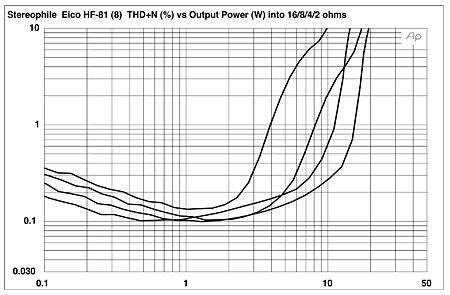
Fig.6 EICO HF-81, 8 ohm tap, distortion (%)vs 1kHz continuous output power into (from bottom to top at 4W): 8, 16, 4, 2 ohms.

Fig.7 EICO HF-81, 4 ohm tap, distortion (%)vs 1kHz continuous output power into (from bottom to top at 3W): 16, 8, 4, 2 ohms.
Figs.8 and 9 show how the THD+N percentage changes with frequency from the 8 and 4 ohm taps, respectively, at 2.83V into loads ranging from 2 to 16 ohms. The distortion is acceptably low only in the midrange, and rises considerably in the bass and at high frequencies, though the HF THD is less severe when the load impedance is higher than the nominal value of the transformer tap. However, as the distortion is almost pure second harmonic (fig.10), it will have less of a deleterious subjective effect than you'd expect.

Fig.8 EICO HF-81, 8 ohm tap, THD+N (%)vs frequency at 2.8V into (from bottom to top at 10kHz): 16, 8, 4, 2 ohms.
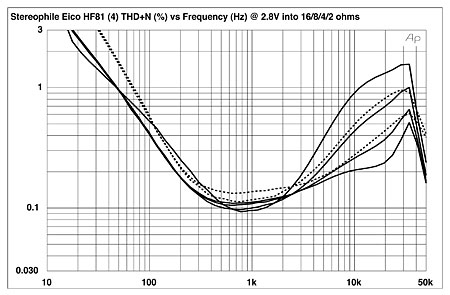
Fig.9 EICO HF-81, 4 ohm tap, THD+N (%)vs frequency at 2.8V into (from bottom to top at 10kHz): 8, 4, 2 ohms.

Fig.10 EICO HF-81, 8 ohm tap, 1kHz waveform at 2W into 4 ohms (top), 0.126% THD+N; distortion and noise waveform with fundamental notched out (bottom, not to scale).
When I see a rise in distortion at low frequencies with a transformer-coupled amplifier, I usually suspect that the transformer's core is starting to saturate, which will introduce odd-order components. However, the spectrum of the HF-81's output while it drives a 50Hz tone into 8 ohms (fig.11) reveals that the second harmonic is still the highest in level, suggesting some output-stage asymmetry instead. Note that the 120Hz AC supply component in this graph lies at a moderately low –80dB. Increasing the signal frequency to 1kHz (fig.12) drops the levels of the harmonics considerably, though now some higher-order odd harmonics can be seen.

Fig.11 EICO HF-81, 4 ohm tap, spectrum of 50Hz sinewave, DC–1kHz, at 3W into 8 ohms (linear frequency scale).
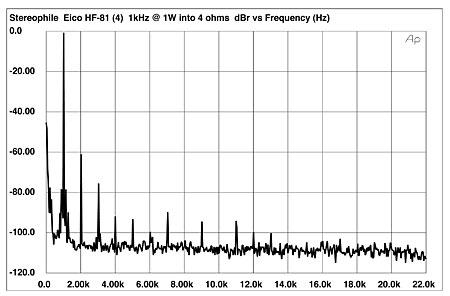
Fig.12 EICO HF-81, 4 ohm tap, spectrum of 1kHz sinewave, DC–10kHz, at 1W into 4 ohms (linear frequency scale).
The HF-81's poor HF linearity, seen in figs.8 and 9, results in a very disappointing result on the high-frequency intermodulation test. At an output power close to visual clipping with the 4 ohm tap driving 4 ohms (fig.13), the 1kHz difference component lies at –48dB (0.4%); the ±120Hz sidebands around each spectral component are evidence of how much this test stresses the amplifier's power supply.
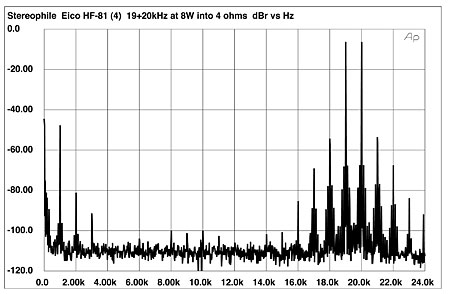
Fig.13 EICO HF-81, 4 ohm tap, HF intermodulation spectrum, DC–24kHz, 19+20kHz at 8W peak into 4 ohms (linear frequency scale).
Finally, I tried to measure the EICO's phono stage in the usual manner by accessing its output at the HF-81's tape-out jacks, but these didn't appear to be functional. I therefore had to look at the signal at the speaker terminals, which means the line stage and tone control stage were both in-circuit. With the EICO hooked up to an 8 ohm load and the tone controls set to 12:00, the phono input's RIAA error is shown in fig.14. Though it meets a ±1dB specification between 80Hz and 10kHz, both the top and bottom octaves are prematurely rolled-off, with a broad depression also evident in the upper midrange and low treble.
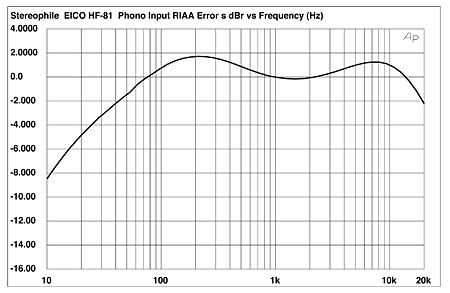
Fig.14 EICO HF-81, phono input RIAA error (2dB/vertical div.).
The input impedance varied from 63k ohms at 20Hz to 42k ohms at 20kHz. The phono stage offered only modest gain, 32.1dB, meaning that it will work best with high-output moving-magnet cartridges. However, the user will run up against the fact that the phono stage appears to have only limited headroom at low and high frequencies. The headroom at 1kHz is an okay 14.8dB, but there is only 6dB of overload margin at 20Hz and just 0.5dB at 20kHz. This is very poor performance.
Although some aspects of its measured performance were okay—the fairly low output impedances, the mainly second-harmonic nature of its distortion signature, the honest power rating—the EICO HF-81's poor low- and high-frequency linearity, its under-performing phono stage, and the idiosyncratic nature of its tone controls leave me scratching my head about why so many audiophiles regard it as one of the best-sounding amplifiers of the "Golden Age."—John Atkinson
- Log in or register to post comments




































